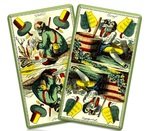The Schnapsen Log
A New Scheme for Remembering Cards
Martin Tompa

I have made the case in the past for the importance of remembering which cards have been played and which still remain unseen. For novice Schnapsen players, I know this memory work seems like a daunting prospect. Yet it is also the most essential skill to master because, without knowing which cards remain unseen, it is impossible to plan the endgame.
Nine years ago, I laid out the details of two different schemes for remembering the cards that have been played. Neither scheme was terribly easy to use and mine sometimes interfered with the part of my brain that was planning the play. Because of this, a friend and I developed a new scheme for remembering the cards that I have been using for nearly two years. It has been quite successful for me. I will describe the new scheme here.
- Pick an order for the suits, let’s say ♦, ♣, ♥, ♠.
- The situation in each suit is encoded as a number, using J=2, Q=3, K=4, T=10, A=20. These are just the point values of the cards in Schnapsen, except for A=20. The reason we can’t use A=11 is because we’re going to add up the values for the cards that have been played, and we need to be able to decode this sum unambiguously. So, for instance, 14 would mean TK of that suit have been played, 33 would mean ATQ of that suit have been played, etc.
- Once you’ve seen all but one card in a suit (including the cards in your hand and the face-up trump on the table), you switch to the name of the card you haven’t seen instead of the sum. (The only unfortunate exception is that you can’t use 10 as the name of the card, because we’ve already used that to mean the 10 is the only card that’s been played. I use “X” as the name of this card, the Roman numeral for 10.) The point of this step is that the cards you haven’t seen provide the point of view you will need in the endgame.
- Once you’ve seen all the cards in a suit, use “Null” for that suit.
- If no cards have yet been played in a suit, use “Zip” for that suit.
As a full example, the encoding “Zip, 24, Null, King” would mean no diamonds played yet, AK of clubs played, all the hearts that you can’t see have been played, and the King is the only spade left that you can’t see.
Keep the current encoding in your head, and update it with each card played to a trick and each card you draw from the stock. One way to calculate which cards are left unseen in a suit is to subtract the count for that suit from 39. For example, if the count for a suit is 35, then 39-35=4 encodes the card you haven’t yet seen, namely the King.
When only one card remains face-down in the stock, I convert the encoding into a list of the six cards that remain unseen, because that’s the viewpoint needed to plan the endgame.
Finally, here is an advanced tip if you are good at doing arithmetic in your head without losing track of everything else you’re remembering. If you cannot recall how many trick points your opponent has, it can be calculated from the current encoding and by looking back at your own tricks.
- Convert any single card back into the sum of cards played in that suit by subtracting its encoding from 39. For example, convert King to 39 - 4 = 35. Similarly, convert Null to 39.
- Subtract 9 from any suit encoding that is at least 20. This changes the count for each Ace from 20 to 11, its correct trick point value.
- Add up the resulting encodings for the four suits. Let E be this sum. E is the trick point total of all cards that have been played so far.
- Look back at your tricks and add up their trick points. Let T be this sum.
- Your opponent’s current trick point score is E-T plus any points for marriages your opponent declared.
© 2022 Martin Tompa. All rights reserved.




